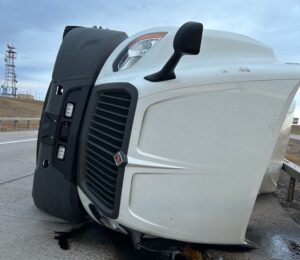SACRAMENTO, Calif. — Gov. Gavin Newsom signed a bill Friday that will make California the first state to require regular smog testing on heavy-duty diesel trucks and tractor-trailers.
Senate Bill 210 requires the California Air Resources Board to set up a pilot program over the next two years and after that put rules in place for truck smog checks. The pilot program will be similar to a smog testing system that’s been in place for decades requiring passenger vehicles that are six years old or older to pass a smog check every two years.
Until now, large trucks have not had such a requirement. Once the program is in place, anyone caught driving a non-gasoline vehicle weighing over 14,000 pounds without a smog certificate can be fined by law enforcement.
Reaction to the bill’s signing was greeted with mixed reactions, with some touting the bill as a long-needed step in the pursuit of improved air quality.
“Just as car owners have to get their own personal cars ‘smog checked’ every two years, so too should truck operators be required to maintain their emissions controls so that we can ensure long lasting air quality improvements here in California,” said state Sen. Connie Leyva, D-Chino, who wrote the bill.
The California Air Resources Board estimates that heavy-duty trucks operating in California account for nearly 60% of the state’s nitrogen oxides emissions — one of the main chemicals that causes smog. The board also estimates that this program could have the effect of eliminating the emissions of 145,000 trucks.
Environmentalists say the new law will reduce emissions of soot and other contaminants, which contribute to high asthma rates in California.
“This is the biggest air quality bill of this year,” said Bill Magavern, policy director for the Coalition for Clean Air. “It’s something we have needed for years. Diesel trucks are the single biggest source of air pollution in California.”
The law also had the support of the American Lung Association, the American Heart Association, the American Cancer Society, Sierra Club California, the Union of Concerned Scientists and other health and environmental organizations.
Opposition to the program was led by the Western States Trucking Association, the California Farm Bureau Federation, California Cattlemen’s Association and several other industry groups.
One of the trucking industry’s arguments is that the bill was unnecessary because of other truck-engine rules that are already in place or are being phased in over the next few years.
Joe Rajkovacz, a spokesman for the Western States Trucking Association, said that the California Air Resources Board already does regular tests for smoke from trucks at weigh stations and trucking companies.
He noted that the board has also set a rule that by 2023 only trucks that are model 2010 or newer can be driven on California roads. That rule was put in place because older trucks pollute far more than newer trucks.
The trucking industry was opposed to that rule, as well, with the cost to trucking companies being the main concern. There is also concern about what this new emissions program could have, especially for smaller companies and to owner-operators.
Companies could be forced to renovate or replace outdated fleets. And while the bill caps the cost of the new required smog checks at $30, it’s just one more expense that needs to be fit into operating budgets, and they are expenses that can’t be put off.
Opponents are also concerned that the new law may allow state officials to take private data from trucking companies if the companies are required to share information stored in their trucks’ on-board computers.
The new law applies to 18-wheelers, along with delivery trucks, dump trucks, tanker trucks, farm trucks and others. The law does not include buses.
Newsom also signed a companion measure, Senate Bill 44, which will require the air resources board to study new emissions technology for medium and heavy-duty vehicles and adopt stricter standards by 2030 and 2050, respectively.
Newsom rounded out his day Friday by issuing an executive order directing state agencies to examine ways to divest from oil and gas in favor of cleaner technologies. Meanwhile, the agencies that manage California’s pension investment portfolio will work with the Newsom administration on a divestment timeline.
The Trucker News Staff produces engaging content for not only TheTrucker.com, but also The Trucker Newspaper, which has been serving the trucking industry for more than 30 years. With a focus on drivers, the Trucker News Staff aims to provide relevant, objective content pertaining to the trucking segment of the transportation industry. The Trucker News Staff is based in Little Rock, Arkansas.















It’s about time
Maybe California should only allow self driven trucks into their state and see how quick they run out of food and necessities. Picking on farmers too? Y’all should go hungry for a little while and think about that one. That is the stupidest thing I ever heard of. One more reason I hate California and love My Texas!!